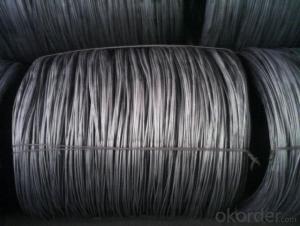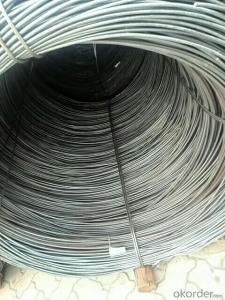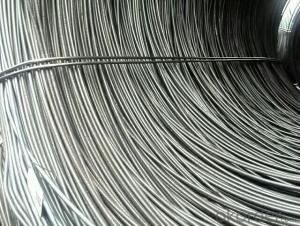Q235 and Sae1008B High quality Wire Rod
- Loading Port:
- Tianjin
- Payment Terms:
- TT OR LC
- Min Order Qty:
- 25 m.t
- Supply Capability:
- 20000 m.t/month
OKorder Service Pledge
OKorder Financial Service
You Might Also Like
Product Description:
OKorder is offering Q235 and Sae1008B High quality Wire Rod at great prices with worldwide shipping. Our supplier is a world-class manufacturer of steel, with our products utilized the world over. OKorder annually supplies products to European, North American and Asian markets. We provide quotations within 24 hours of receiving an inquiry and guarantee competitive prices.
Product Applications:
Q235 and Sae1008B High quality Wire Rod ideal for structural applications and are widely used in the construction of buildings and bridges, and the manufacturing, petrochemical, and transportation industries.
Product Advantages:
Q235 and Sae1008B High quality Wire Rod are durable, strong, and resist corrosion.
Main Product Features:
· Premium quality
· Prompt delivery & seaworthy packing (30 days after receiving deposit)
· Corrosion resistance
· Can be recycled and reused
· Mill test certification
· Professional Service
· Competitive pricing
Product Description:
Specifications of Q235 and Sae1008B High quality Wire Rod :
Steel Grade: sae1006+sae1008B , Standard: GB Diameter: 5.5mm, 6.5mm, 7mm,8mm,9mm,10mm,12mm,14mm
Diameter Tolerance:±0.3mm 6.5mm can be drawing into 2mm/8.0mm can be drawing into 3mm
Brand Name: N-RIVER Place of Origin: Hebei, China Mainland Application: construction, building etc
Chemical Composition:
Please kindly find our chemistry of our material based on Q235 as below for your information
Trademark | Rank | Chemical composition (quality score) % | ||||||
C | Si | Mn | S | P | ||||
| ≤ |
| ≤ | ≤ | ||||
Q235 | A | 0.14-0.22 | 0.30 | 0.30-0.65 | 0.050 | 0.045 | ||
Q235 | B | 0.12-0.20 | 0.30 | 0.30-0.70 | 0.045 | 0.045 | ||
Trademark | Rank | Pulling Test | ||||||
Bend PointΔs/Mpa | Tensile Strength | Elongation Ratioδ5% | ||||||
Thickness (Diameter) /MM | Thickness (Diameter) /MM | |||||||
≤16 | 16-40 | ≤16 | 16-40 | |||||
≥ | ≥ | |||||||
Q235 | A | 235 | 225 | 375-500 | 26 | 25 | ||
Q235 | B | 235 | 225 | 375-500 | 26 | 25 | ||
Usage and Applications of Sae1006B and Q235 High quality Wire Rod :
After hot-rolled the products shaped into coil and delivery as finished product, including round, square, rectangular, hexagonal and so on. Since most of the products are round, it is generally called wire rod. Carbon steel wire rod is widely used in construction and manufacturing. Carbon steel wire rod is mainly used for reinforcement of reinforced concrete and welded structure or reprocessed (roberts , nail, etc.) materials, especially used to produce wire drawing, welding electrode, nails, spring, electronic, precise machinery parts and so on.
Packaging & Delivery of Q235 and Sae1008B High quality Wire Rod :
Packaging Detail: products are packed in coil and then shipped by container or bulk vessel
Each coil weight: 2-3MT
Delivery Detail: within 45 days after received deposit or LC.
Label: to be specified by customer, generally, each bundle has 1-2 labels
Trade terms: FOB, CFR, CIF
FAQ:
Q1: Why buy Materials & Equipment from OKorder.com?
A1: All products offered byOKorder.com are carefully selected from China's most reliable manufacturing enterprises. Through its ISO certifications, OKorder.com adheres to the highest standards and a commitment to supply chain safety and customer satisfaction.
Q2: Can stainless steel rust?
A2: Stainless does not "rust" as you think of regular steel rusting with a red oxide on the surface that flakes off. If you see red rust it is probably due to some iron particles that have contaminated the surface of the stainless steel and it is these iron particles that are rusting. Look at the source of the rusting and see if you can remove it from the surface.
Q3: How soon can we receive the product after purchase?
A3: Within three days of placing an order, we will begin production. The specific shipping date is dependent upon international and government factors, but is typically 7 to 10 workdays.
Images:
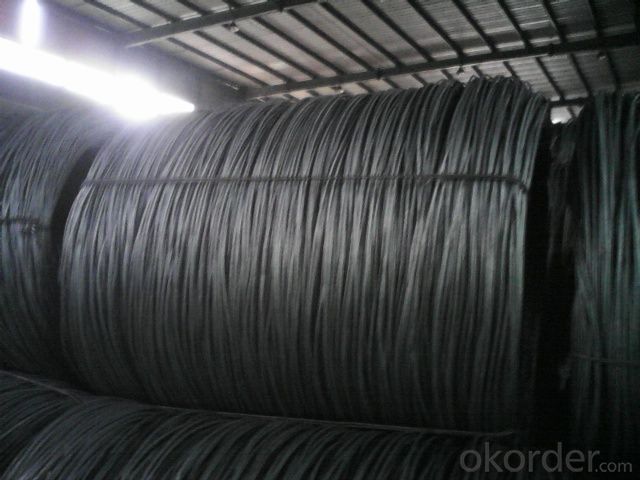
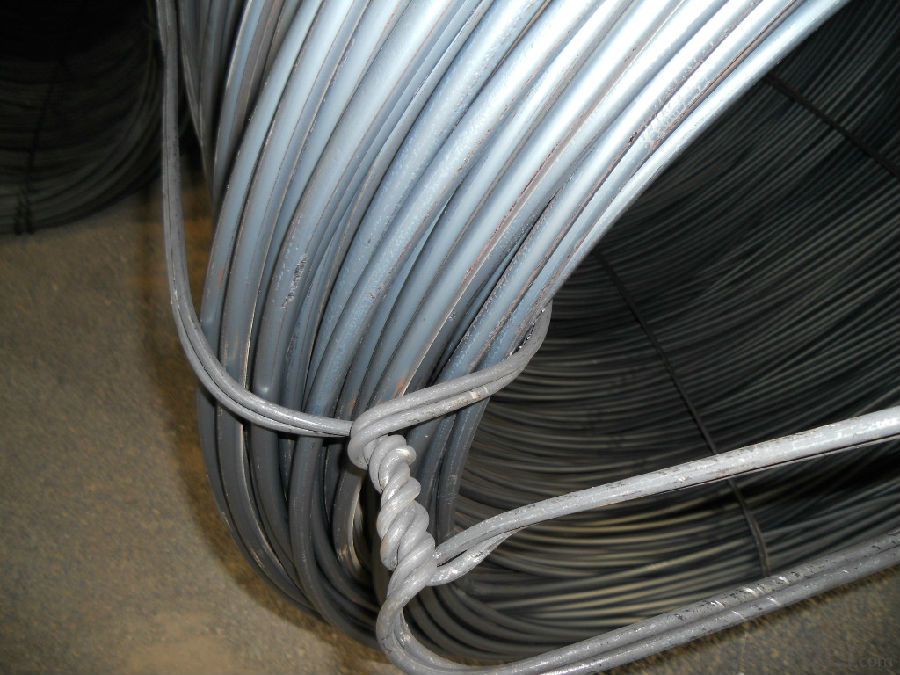
- Q:What are the standard straightness requirements for steel wire rod?
- The steel wire rod typically adheres to industry standards or customer specifications to maintain its standard straightness. These requirements are crucial in ensuring that the wire rod has a uniform and straight shape, which is essential for its intended uses. One common requirement for steel wire rod straightness is the maximum allowable deviation from a straight line. This is usually expressed as the maximum bow or camber, indicating the amount of deviation when the wire rod is laid flat on a surface. Meeting this requirement ensures that the wire rod can be easily processed and utilized in various manufacturing processes like drawing, cold heading, or welding. Another straightness requirement for steel wire rod is the maximum permissible twist or helix. This refers to the amount of rotational or spiral distortion along the wire rod's length. Excessive twist can negatively impact the wire rod's performance, particularly in applications where it needs to be threaded through tight spaces or used in precision machinery. Moreover, specific tolerances for straightness may exist for different sections or lengths of the wire rod. For instance, the requirement for straightness might be more stringent at the ends or specific portions of the wire rod. These variations in straightness requirements are often determined based on the wire rod's intended application or the customer's specific needs. Overall, the standard straightness requirements for steel wire rod aim to ensure that the product meets the necessary quality standards and can be effectively utilized in various manufacturing processes. Adhering to these requirements guarantees that the wire rod performs consistently and reliably in its intended applications.
- Q:What are the different surface finishing materials used for steel wire rod?
- There are several surface finishing materials that are commonly used for steel wire rod. Some of these materials include zinc, copper, nickel, and chrome. These finishes are applied to the steel wire rod to enhance its corrosion resistance, improve its appearance, and provide additional functionality such as improved conductivity or lubricity.
- Q:What are the different tolerances for steel wire rods?
- The tolerances for steel wire rods can vary depending on the specific application and industry standards. However, there are generally accepted tolerance ranges for various dimensions of steel wire rods. One common tolerance is for the diameter or thickness of the wire rod. This can range from a few millimeters to several inches, depending on the intended use. For example, in the construction industry, wire rods used for reinforcing concrete may have a tolerance of +/- 0.5 mm, while wire rods used for manufacturing automotive components may have a tighter tolerance of +/- 0.1 mm. Another important tolerance to consider is the straightness of the wire rod. This refers to how straight the rod is along its entire length. Straightness tolerances can range from a few millimeters to a few centimeters per meter. For applications that require precise alignment, such as in the production of precision instruments or machinery, tighter straightness tolerances are necessary. Surface finish is another factor that can have specific tolerances for steel wire rods. This refers to the condition of the surface, including any imperfections or irregularities. Depending on the intended use, surface finish tolerances can range from as rough as a few micrometers to as smooth as a mirror-like finish. It's important to note that these tolerance ranges may vary slightly depending on the specific standards set by different organizations or countries. For instance, the American Society for Testing and Materials (ASTM) has its own set of tolerances for steel wire rods, while the International Organization for Standardization (ISO) has its own standards as well. In conclusion, the tolerances for steel wire rods can vary depending on factors such as diameter, straightness, and surface finish. These tolerances are essential to ensure that the wire rods meet the required specifications and can perform effectively in their intended applications.
- Q:How is steel wire rod packaged for transportation?
- Steel wire rod is typically packaged for transportation by being bundled together and secured with steel strapping or wire ties. The bundles are then stacked on wooden pallets or loaded into steel crates for added protection. Additionally, some manufacturers may opt for further packaging using shrink wrap or plastic covers to safeguard the wire rod from moisture, dust, and other potential damages during transit.
- Q:What are the common industry opportunities for steel wire rod?
- Some common industry opportunities for steel wire rod include its use in construction, automotive manufacturing, infrastructure development, and various industrial applications. Steel wire rod is often used to reinforce concrete structures, create wire mesh for fencing and screening, manufacture automotive parts like suspension springs and cables, and support the development of railways, bridges, and power transmission lines. Additionally, it finds application in the production of wire products, such as nails, screws, and springs, as well as in the manufacturing of electrical cables and wires.
- Q:How is steel wire rod used in the manufacturing of wire forms for agricultural machinery?
- Steel wire rod is used in the manufacturing of wire forms for agricultural machinery as it provides the necessary strength and durability required for these applications. The wire rod is typically shaped and bent into various forms such as springs, hooks, or brackets, which are then incorporated into the machinery. These wire forms play a critical role in supporting different components, providing stability, and facilitating the efficient operation of agricultural equipment.
- Q:What are the key success factors for companies in the steel wire rod industry?
- Companies operating in the steel wire rod industry can achieve success by focusing on various key factors. To begin with, maintaining a strong emphasis on quality is essential. Steel wire rod is widely used in industries such as automotive, construction, and electrical, so it is crucial to maintain high-quality standards that meet the requirements of different applications. Additionally, companies in this industry should strive for a robust and efficient manufacturing process. This involves investing in modern equipment and technology to improve production efficiency, reduce costs, and enhance overall productivity. Continuous improvement in process optimization and waste reduction is also necessary to remain competitive. Another critical factor is establishing a well-diversified customer base. The steel wire rod market is highly competitive, and companies must have solid relationships with a diverse range of customers to ensure a steady demand for their products. Developing long-term partnerships with customers and understanding their specific needs and preferences are vital for maintaining a competitive edge. Furthermore, effective supply chain management is vital for success. Companies need to secure a stable and cost-effective supply of raw materials, such as steel billets, to ensure uninterrupted production. Additionally, maintaining good relationships with suppliers and implementing efficient logistics strategies are essential to minimize lead times and meet customer demands promptly. Moreover, a strong focus on innovation and research and development is crucial in this industry. Companies that invest in developing new products, improving existing ones, and exploring new applications for steel wire rod will gain a competitive advantage. This can involve collaborating with customers, research institutes, and industry partners to stay ahead of market trends and offer innovative solutions. Lastly, companies in the steel wire rod industry should prioritize sustainability and environmental responsibility. This includes implementing sustainable manufacturing practices, reducing carbon emissions, and minimizing waste generation. Given the growing demand for environmentally-friendly products, companies that adopt and promote sustainable practices will be better positioned for long-term success. In conclusion, key success factors for companies in the steel wire rod industry encompass quality control, efficient manufacturing processes, a diversified customer base, effective supply chain management, innovation, and sustainability. By focusing on these factors, companies can position themselves for growth and competitiveness in the market.
- Q:How is steel wire rod classified based on its strength?
- Steel wire rod is classified based on its strength through a grading system known as the grade or grade number. The grade number indicates the tensile strength of the steel wire rod, which is the maximum amount of stress the wire rod can withstand before breaking. The higher the grade number, the stronger the wire rod is. The classification of steel wire rod based on its strength typically ranges from grade 1000 to grade 4000. Grade 1000 wire rod has the lowest tensile strength, usually around 1000 megapascals (MPa), while grade 4000 wire rod has the highest tensile strength, typically around 4000 MPa. Each grade of wire rod is designed for specific applications and industries. Lower grade wire rods are suitable for less demanding applications such as general construction, fencing, and mesh manufacturing. They are often used where high strength is not a primary requirement. On the other hand, higher grade wire rods are used in industries where exceptional strength is crucial, such as automotive, aerospace, and manufacturing of high-tensile steel cables. These wire rods are engineered to withstand extreme forces and are typically used in critical applications that require superior strength and performance. In addition to the tensile strength, steel wire rod can also be classified based on other properties such as ductility, corrosion resistance, and formability. These properties play a significant role in determining the suitability of the wire rod for specific applications. Overall, the classification of steel wire rod based on its strength is essential in selecting the right material for various applications. It allows engineers and manufacturers to choose wire rods that can withstand the required forces and perform optimally in their respective industries.
- Q:How is steel wire rod used in the production of wire mesh for erosion control?
- Steel wire rod plays a vital role in the manufacturing of wire mesh used for erosion control. The initial step involves passing the wire rod through a series of machines to undergo wire drawing, a process that stretches it to a smaller diameter and molds it into a continuous wire. This wire is then further processed to achieve the desired thickness and strength needed for erosion control applications. When producing wire mesh for erosion control, the steel wire rod is commonly woven or welded together to form a mesh structure. This mesh acts as a physical barrier, preventing soil erosion by securely holding the soil in place, particularly on inclined surfaces or areas susceptible to water flow. The steel wire rod's exceptional tensile strength and durability make it an ideal material for erosion control purposes. The wire mesh created from this rod exhibits the ability to withstand harsh environmental conditions, such as heavy rainfall or strong water currents, without distorting or breaking. By adjusting the gauge and spacing of the wires, the wire mesh can be customized to meet specific erosion control requirements. For applications demanding greater strength and stability, like retaining walls or embankments, thicker wires and narrower spacing are utilized. Conversely, thinner wires and wider spacing may be suitable for less demanding erosion control situations, such as stabilizing soil in residential properties or landscaping projects. In conclusion, the utilization of steel wire rod in the production of wire mesh for erosion control offers a reliable and long-lasting solution to prevent soil erosion. Its versatility enables customization based on specific project needs, guaranteeing the implementation of efficient erosion control measures in various applications.
- Q:How does the magnetic properties of steel wire rod vary with different grades?
- The magnetic characteristics of steel wire rod can differ significantly depending on the grade. The magnetic behavior of steel primarily depends on its composition and microstructure, both of which can be modified in various ways to achieve different grades. Generally, steel wire rods with a higher carbon content tend to possess lower magnetic properties. This is because carbon atoms disrupt the alignment of the steel's magnetic domains, resulting in a decrease in overall magnetic strength. As a result, low carbon steel grades, like AISI 1006 or SAE J403 Grade 1006, typically display weaker magnetic properties. Conversely, steel wire rods containing higher levels of alloying elements, such as chromium, nickel, or manganese, usually exhibit enhanced magnetic strength. These alloying elements can affect the microstructure of the steel, promoting the formation of magnetic domains and improving magnetization overall. Stainless steel grades, which contain significant amounts of chromium and nickel, often demonstrate stronger magnetic properties compared to low carbon steel grades. It is important to note that while certain steel grades may inherently possess stronger or weaker magnetic properties, the specific manufacturing processes and heat treatments employed during the production of wire rods can also influence magnetic behavior. Different heat treatments can modify the microstructure and induce the precipitation of various phases in the steel, thereby impacting its magnetic properties. In conclusion, the magnetic properties of steel wire rod differ across various grades due to disparities in composition, alloying elements, and microstructure. Steel grades with higher carbon content generally exhibit weaker magnetic properties, while those with higher alloying elements tend to have increased magnetization. Additionally, the magnetic behavior of steel wire rod can also be affected by the specific manufacturing processes and heat treatments employed.
1. Manufacturer Overview |
|
|---|---|
| Location | |
| Year Established | |
| Annual Output Value | |
| Main Markets | |
| Company Certifications | |
2. Manufacturer Certificates |
|
|---|---|
| a) Certification Name | |
| Range | |
| Reference | |
| Validity Period | |
3. Manufacturer Capability |
|
|---|---|
| a)Trade Capacity | |
| Nearest Port | |
| Export Percentage | |
| No.of Employees in Trade Department | |
| Language Spoken: | |
| b)Factory Information | |
| Factory Size: | |
| No. of Production Lines | |
| Contract Manufacturing | |
| Product Price Range | |
Send your message to us
Q235 and Sae1008B High quality Wire Rod
- Loading Port:
- Tianjin
- Payment Terms:
- TT OR LC
- Min Order Qty:
- 25 m.t
- Supply Capability:
- 20000 m.t/month
OKorder Service Pledge
OKorder Financial Service
Similar products
New products
Hot products
Hot Searches
Related keywords
